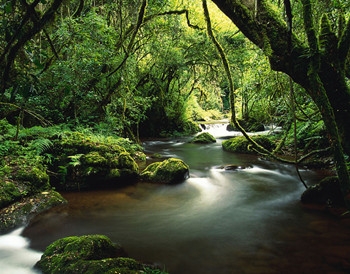
This triggered other dramatic changes. As sea levels dropped, so did the inland water tables. Florida's fresh water drained away through the porous limestone rock. Pools dried up and springs diminished. Florida was on the brink of drought. And animals would have had to travel to find food and water. So each year, mastodons would have migrated to the wetter regions.
這引起了其他的一些巨大變化。海平面越降越低,內(nèi)陸水位也是一樣。佛羅里達(dá)的淡水都從多孔的石灰?guī)r中流走。小水池和泉水都干涸了。佛羅里達(dá)處于干旱的邊緣。動(dòng)物們必須長途跋涉以尋找食物和水源。因此,每年乳齒象都是遷徙都更加濕潤的地區(qū)。
But in a few key places, water was still pushed up from underground as a spring, a vital oasis where wildlife would have converged from many miles around. Many animals would have fed on the surrounding vegetation and others come here to drink. And predators would have laid an ambush for the unwary. It's no wonder that so many fossil bones have been found on the bottom of these springs, clues that can open up a window on the ice age past.
但是在一些關(guān)鍵的地區(qū),淡水還是能夠從地表流出形成泉水,這就成型了一個(gè)重要的綠洲,幾公里外的動(dòng)物們都會(huì)因此聚集到一起。很多動(dòng)物都會(huì)以周圍的植被為食,也有一些只是到這里飲水。而肉食動(dòng)物則會(huì)在這里埋伏著,準(zhǔn)備對(duì)那些不警惕的動(dòng)物們來個(gè)出其不意。毫無疑問,在這些泉水的河底能夠發(fā)現(xiàn)很多化石骨骼,這些骨骼會(huì)我們更好地了解冰河時(shí)代的過去提供了重要的依據(jù)。
Bringing this evidence together, we can create a living picture of this region as it was then. We can now go back 13,000 years and see what a day around one of Florida's springs might have been like.
將這些線索集合起來,我們就能夠想象出這個(gè)地區(qū)過去是什么樣子。現(xiàn)在我們返回13000年前,看看佛羅里達(dá)小溪的一天究竟是什么樣子。
Dawn on the southeast tip of ice age North America. On the banks of a spring-fed pool, the early grazers stir.
我們會(huì)逐漸了解這次向著冰河時(shí)代的北美東南之行。在泉水的河岸處,早起的吃草動(dòng)物在徘徊著。
英文文本來自普特英語,譯文屬可可原創(chuàng),僅供學(xué)習(xí)交流使用,未經(jīng)許可不得轉(zhuǎn)載。











